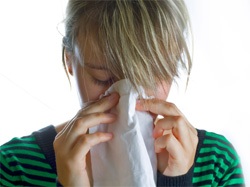Acupuncture and Allergy: Editorial from the Annals of Internal Medicine
Kristen Sparrow • February 21, 2013


From the Annals of Internal Medicine:
To be considered effective, a pharmaceutical intervention genrally needs to be proven more effective than placebo. Most suregical interventions, however, are not held to this standard. With some exceptions including vertebral kyphoplasty and knee arthroscopy, surgical interventions have not been subjected to sham surgery-controlled trials. Acupuncture, on the other hand, has undergone extensive study with large, sham-controlled clinical trials. Over the past 15 years there have been enough good-quality clinical trials of acupuncture to support patient-level meta-analysis for several clinical indications. One such recently published analysis for chronic pain conditions (back and neck pain, osteoarthritis, headache, and shoulder pain) involving a total of 17922 patients showed that acupuncture was superior to both sham and no-acupuncture controls for each pain condition. In contrast, few, if any, surgical interventions have been shown to be more effective than a sham procedures in the context of a randomized, controlled trials.
I didn’t purchase the whole editorial, but, again, given the safety and relative cheapness of acupuncture, not sure why it’s singled out for “need for effectiveness” proof versus surgery.
Abstract from the same journal looking at Acupuncture for Seasonal Allergy
Ann Intern Med. 2013 Feb 19;158(4):225-34. doi: 10.7326/0003-4819-158-4-201302190-00002.
Acupuncture in patients with seasonal allergic rhinitis: a randomized trial.
Brinkhaus B, Ortiz M, Witt CM, Roll S, Linde K, Pfab F, Niggemann B, Hummelsberger J, Treszl A, Ring J, Zuberbier T, Wegscheider K, Willich SN.
Abstract
Acupuncture is frequently used to treat seasonal allergic rhinitis (SAR) despite limited scientific evidence.
OBJECTIVE:
To evaluate the effects of acupuncture in patients with SAR.
DESIGN:
Randomized, controlled multicenter trial. (ClinicalTrials.gov: NCT00610584)
SETTING:
46 specialized physicians in 6 hospital clinics and 32 private outpatient clinics.
PATIENTS:
422 persons with SAR and IgE sensitization to birch and grass pollen.
INTERVENTION:
Acupuncture plus rescue medication (RM) (cetirizine) (n = 212), sham acupuncture plus RM (n = 102), or RM alone (n = 108). Twelve treatments were provided over 8 weeks in the first year.
MEASUREMENTS:
Changes in the Rhinitis Quality of Life Questionnaire (RQLQ) overall score and the RM score (RMS) from baseline to weeks 7 and 8 and week 16 in the first year and week 8 in the second year after randomization, with predefined noninferiority margins of -0.5 point (RQLQ) and -1.5 points (RMS).
RESULTS:
Compared with sham acupuncture and with RM, acupuncture was associated with improvement in RQLQ score (sham vs. acupuncture mean difference, 0.5 point [97.5% CI, 0.2 to 0.8 point; P < 0.001]; RM vs. acupuncture mean difference, 0.7 point [97.5% CI, 0.4 to 1.0 point; P < 0.001]) and RMS (sham vs. acupuncture mean difference, 1.1 points [97.5% CI, 0.4 to 1.9 points; P < 0.001]; RM vs. acupuncture mean difference, 1.5 points [97.5% CI, 0.8 to 2.2 points; P < 0.001]). There were no differences after 16 weeks in the first year. After the 8-week follow-up phase in the second year, small improvements favoring real acupuncture over the sham procedure were noted (RQLQ mean difference, 0.3 point [95% CI, 0.03 to 0.6 point; P = 0.032]; RMS mean difference, 1.0 point [95% CI, 0.2 to 1.9 points; P = 0.018]).
LIMITATION:
The study was not powered to detect rare adverse events, and the RQLQ and RMS values were low at baseline.
CONCLUSION:
Acupuncture led to statistically significant improvements in disease-specific quality of life and antihistamine use measures after 8 weeks of treatment compared with sham acupuncture and with RM alone, but the improvements may not be clinically significant.
PRIMARY FUNDING SOURCE:
German Research Foundation.
and this article
Allergy. 2013 Mar;68(3):365-74. doi: 10.1111/all.12053. Epub 2012 Dec 18.
A multicenter, randomized, controlled trial testing the effects of acupuncture on allergic rhinitis.
Choi SM, Park JE, Li SS, Jung H, Zi M, Kim TH, Jung S, Kim A, Shin M, Sul JU, Hong Z, Jiping Z, Lee S, Liyun H, Kang K, Baoyan L.
Source
Department of Medical Research, Korea Institute of Oriental Medicine, Daejeon, South Korea.
Abstract
BACKGROUND:
The aim of this study was to evaluate the efficacy and safety of acupuncture in the treatment for allergic rhinitis.
METHODS:
This study was a multicenter, randomized, parallel-controlled study. Participants were randomized to either the active acupuncture, sham acupuncture, or waitlist groups. The active and sham acupuncture groups received acupuncture treatment three times per week for 4 weeks. In the sham group, minimal acupuncture at nonacupuncture points was used. The waitlist group did not receive any acupuncture treatment.
RESULTS:
Of the 238 participants, 97, 94, and 47 individuals were assigned to the active acupuncture, sham acupuncture, and waitlist group, respectively. After the treatment, the difference in the total nasal symptom score (TNSS) was significantly reduced in the active acupuncture group compared with the sham acupuncture (difference: -1.03, 95% confidence interval [CI]: -1.96, -0.09, P = 0.03) and waitlist (difference: -2.49, 95% CI: -3.68, -1.29, P < 0.0001). The active acupuncture group exhibited a significant change in the total non-nasal symptom score (TNNSS) compared with the waitlist (difference: -0.78, 95% CI: -1.22, -0.34, P = 0.0002), but not the sham acupuncture group (difference; 0.15, 95% CI: -0.21, 0.5, P = 0.56). Both active and sham acupuncture treatments resulted in significant improvements in TNSS and TNNSS compared to baseline.
CONCLUSION:
Active acupuncture showed a significantly greater effect on symptoms of allergic rhinitis than either sham acupuncture or no active treatment. The symptoms of allergic rhinitis decreased significantly after treatment in the both acupuncture and sham acupuncture groups. Acupuncture appears to be an effective and safe treatment for allergic rhinitis.

